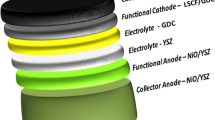Abstract
Thin film solid oxide fuel cells with nickel oxide–gadolinia doped ceria anodes deposited by sputtering were operated at 500 °C. The fuel cells each have 750 nm–yttria-stabilized zirconia electrolytes and 200 nm–platinum cathodes. The thicknesses of the anodes are 240 nm, 320 nm, and 400 nm. The cell with the 320-nm-thick anode showed the highest maximum power density among all cells. Through electrochemical impedance spectroscopy, the anodic activation resistance and the ohmic resistance were calculated. The anodic activation loss decreased with an increase in the anode thickness. Therefore, the cell with the 400-nm-thick anode showed the lowest activation polarization resistance. Additionally, the ohmic resistance, the sum of various electronic/ionic resistances, was lowest when using the 320-nm-thick anode. The electronic resistance and the ionic resistance of the anode were found to exist in a trade-off relationship owing to the current-collecting method of the anode.
Similar content being viewed by others
Abbreviations
- a:
-
partial pressure of the gas
- E:
-
open circuit voltage
- R:
-
real impedance (resistance)
- Δs:
-
molar reaction entropy
- T:
-
temperature
References
O’Hayre, R., Cha, S. W., Colella W., and Prinz, F. B., “Fuel Cell Fundamentals,” John Willey & Son, 2nd Ed., pp. 3–20, 141-143, 261-271, 301-319, 2009.
Goodenough, J. B. and Huang, Y.-H., “Alternative Anode Materials for Solid Oxide Fuel Cells,” Journal of Power Sources, Vol. 173, No. 1, pp. 1–10, 2007.
Ji, S., Chang, I., Cho, G. Y., Lee, Y. H., Shim, J. H., and Cha, S. W., “Application of Dense Nano-Thin Platinum Films for Low-Temperature Solid Oxide Fuel Cells by Atomic Layer Deposition,” international Journal of Hydrogen Energy, Vol. 39, No. 23, pp. 12402–12408, 2014.
Chao, C.-C., Hsu, C.-M., Cui, Y., and Prinz, F. B., “Improved Solid Oxide Fuel Cell Performance with Nanostructured Electrolytes,” ACS Nano, Vol. 5, No. 7, pp. 5692–5696, 2011.
Scherrer, B., Schlupp, M. V., Stender, D., Martynczuk, J., Grolig, J. G., et al., “On Proton Conductivity in Porous and Dense Yttria Stabilized Zirconia at Low Temperature,” Advanced Functional Materials, Vol. 23, No. 15, pp. 1957–1964, 2013.
Zhu, W. and Deevi, S., “A Review on the Status of Anode Materials for Solid Oxide Fuel Cells,” Materials Science and Engineering: A, Vol. 362, No. 1, pp. 228–239, 2003.
Reddy, K. R. and Karan, K., “Sinterability, Mechanical, Microstructural, and Electrical Properties of Gadolinium-Doped Ceria Electrolyte for Low-Temperature Solid Oxide Fuel Cells,” Journal of Electroceramics, Vol. 15, No. 1, pp. 45–56, 2005.
Ishihara, T., Shibayama, T., Nishiguchi, H., and Takita, Y., “Nickel-Gd-Doped CeO2 Cermet Anode for Intermediate Temperature Operating Solid Oxide Fuel Cells using LaGaO3-based Perovskite Electrolyte,” Solid State Ionics, Vol. 132, No. 3, pp. 209–216, 2000.
Ayawanna, J., Wattanasiriwech, D., Wattanasiriwech, S., and Sato, K., “Effects of NiO/GDC Ratios and Additives on Electrical Properties of SOFC Anodes,” Materials and Manufacturing Processes, Vol. 29, No. 7, pp. 767–770, 2014.
Fu, C., Chan, S. H., Liu, Q., Ge, X., and Pasciak, G., “Fabrication and Evaluation of Ni-GDC Composite Anode Prepared by Aqueous-based Tape Casting Method for Low-Temperature Solid Oxide Fuel Cell,” International Journal of Hydrogen Energy, Vol. 35, No. 1, pp. 301–307, 2010.
Ahn, J. S., Omar, S., Yoon, H., Nino, J. C., and Wachsman, E. D., “Performance of Anode-Supported Solid Oxide Fuel Cell using Novel Ceria Electrolyte,” Journal of Power Sources, Vol. 195, No. 8, pp. 2131–2135, 2010.
Ding, C., Lin, H., Sato, K., and Hashida, T., “Synthesis of NiOCe0.9Gd0.1O1.95 Nanocomposite Powders for Low-Temperature Solid Oxide Fuel Cell Anodes by Co-Precipitation,” Scripta Materialia, Vol. 60, No. 4, pp. 254–256, 2009.
Park, J., Chang, I., Paek, J. Y., Ji, S., Lee, W., et al., “Fabrication of the Large Area Thin-Film Solid Oxide Fuel Cells,” CIRP Annals-Manufacturing Technology, Vol. 63, No. 1, pp. 513–516, 2014.
Kim, M., Ha, Y.-C., Nguyen, T. N., Choi, H. Y., and Kim, D., “Extended Self-Ordering Regime in Hard Anodization and Its Application to Make Asymmetric AAO Membranes for Large Pitch-Distance Nanostructures,” Nanotechnology, Vol. 24, No. 50, Paper No. 505304, 2013.
Ji, S., Chang, I., Lee, Y. H., Park, J., Paek, J. Y., et al., “Fabrication of Low-Temperature Solid Oxide Fuel Cells with a Nanothin Protective Layer by Atomic Layer Deposition,” Nanoscale Research Letters, Vol. 8, No. 1, pp. 1–7, 2013.
An, J., Kim, Y.-B., Park, J., Gur, T. M., and Prinz, F. B., “Three-Dimensional Nanostructured Bilayer Solid Oxide Fuel Cell with 1.3 W/cm2 at 450°C,” Nano Letters, Vol. 13, No. 9, pp. 4551–4555, 2013.
Chen, W., Nauels, N., Bouwmeester, H. J., Nijmeijer, A., and Winnubst, L., “An Accurate Way to Determine the Ionic Conductivity of Mixed Ionic-Electronic Conducting (MIEC) Ceramics,” Journal of the European Ceramic Society, Vol. 35, No. 11, pp. 3075–3083, 2015.
Wachsman, E. D. and Lee, K. T., “Lowering the Temperature of Solid Oxide Fuel Cells,” Science, Vol. 334, No. 6058, pp. 935–939, 2011.
Author information
Authors and Affiliations
Corresponding author
Rights and permissions
About this article
Cite this article
Kim, Y., Noh, S., Cho, G.Y. et al. Characterization of thin film solid oxide fuel cells with variations in the thickness of nickel oxide-gadolinia doped ceria anode. Int. J. Precis. Eng. Manuf. 17, 1079–1083 (2016). https://doi.org/10.1007/s12541-016-0131-8
Received:
Revised:
Accepted:
Published:
Issue Date:
DOI: https://doi.org/10.1007/s12541-016-0131-8




